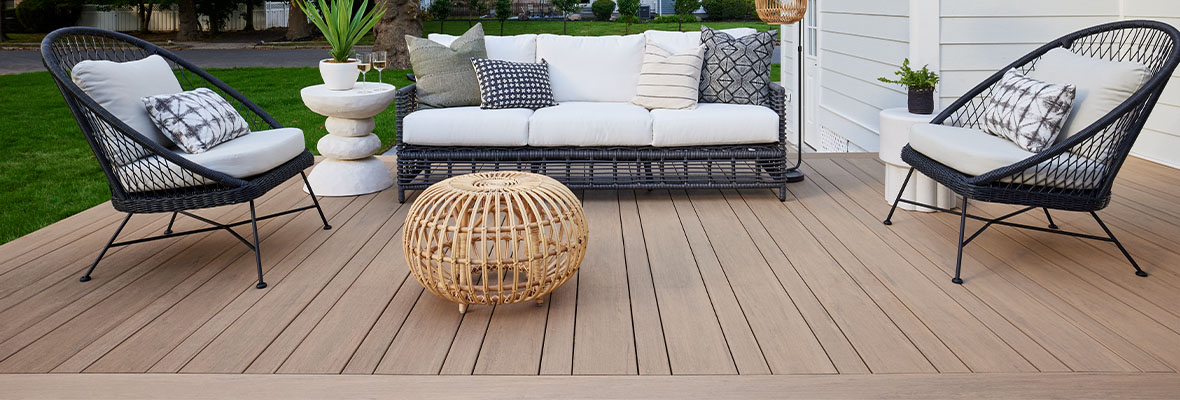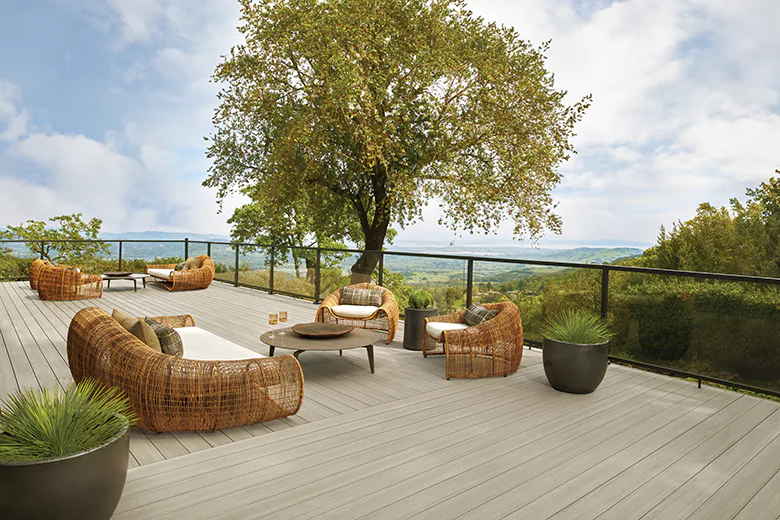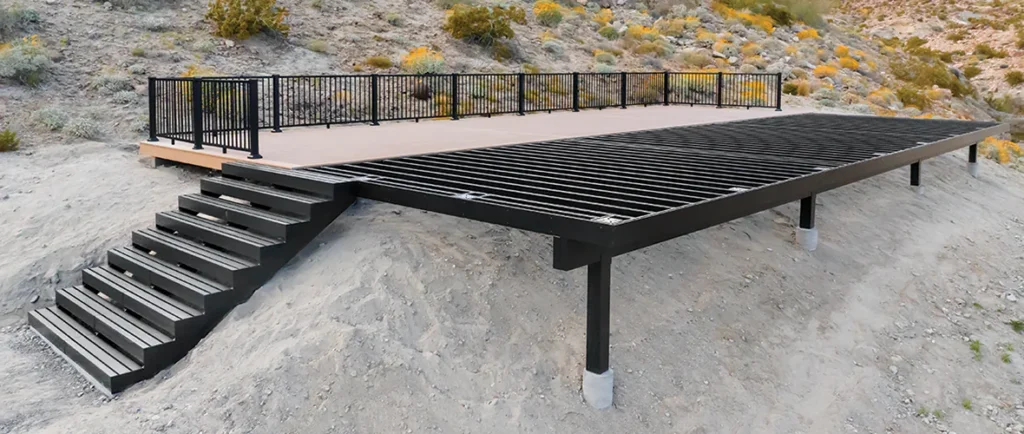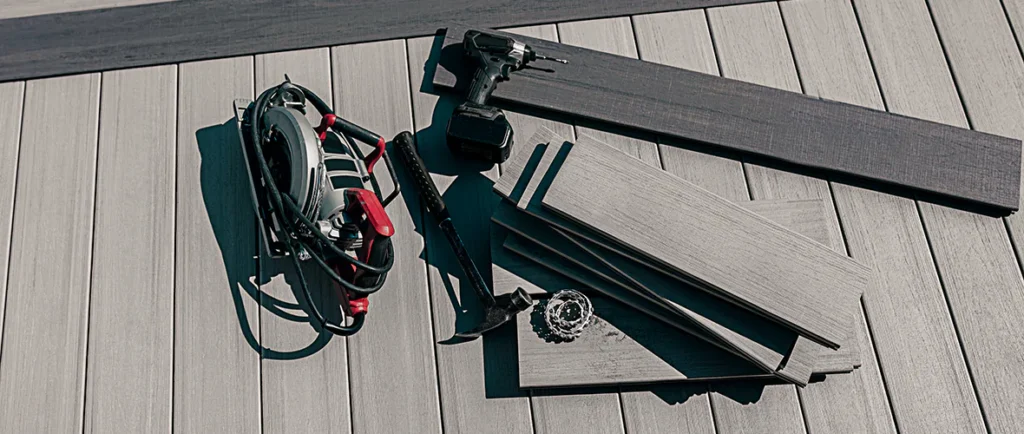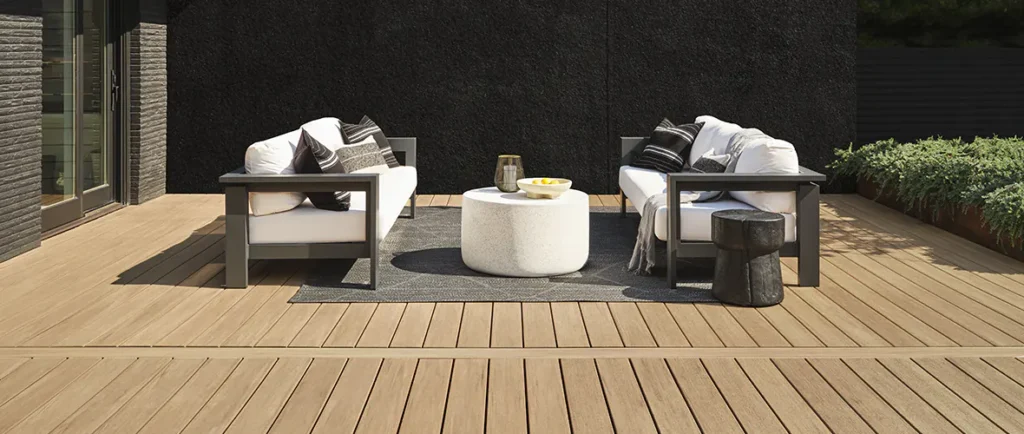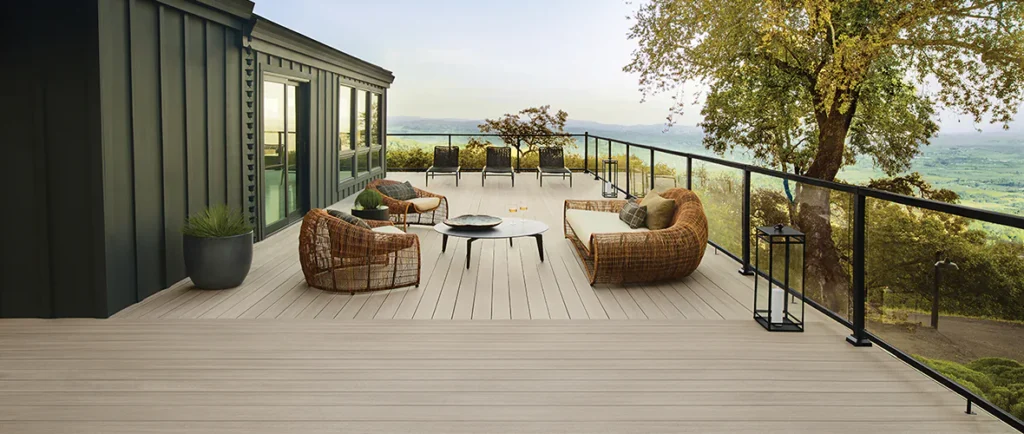You may already have mood boards of your dream deck’s shape, color, and decor, and are ready to bring inspiration to life. These are core deck design elements to explore, but don’t forget to play with your deck pattern.
A creative decking pattern adds personality and polish to your deck. It’s also a beautiful way to define deck spaces and flow.
There are several classic patterns to consider, so we’ve pulled our favorite motifs and labeled them by complexity so you can choose the perfect style for your project. Just be sure to plan your future furniture layout in a way that best showcases your stunning deck pattern.
In This Article:
1. Simple single-width pattern
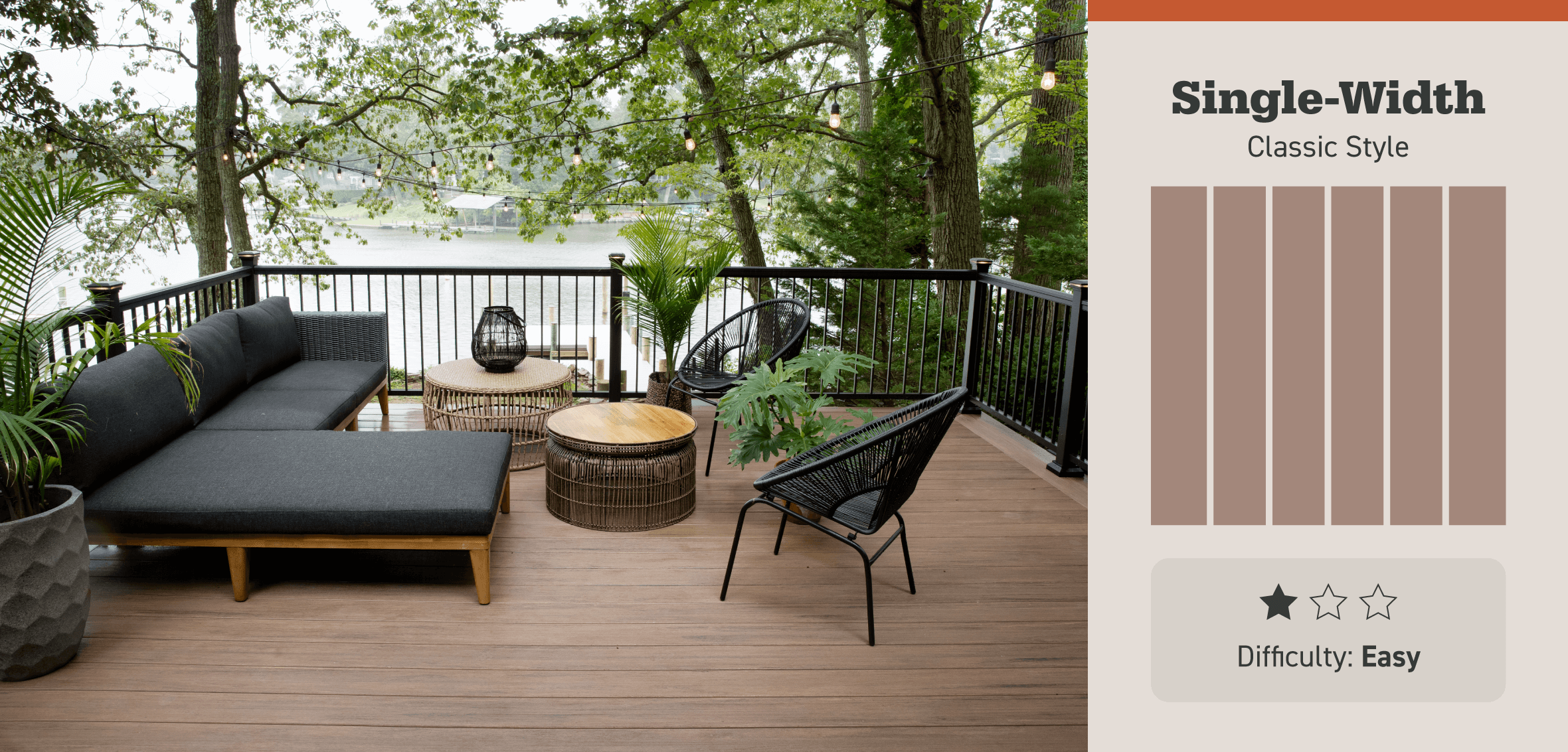
Style: Classic
Difficulty: Easy
Single width is a deck pattern where the inlay is made up of the same width of boards across the entire deck. This go-to deck pattern has stood the test of time for a reason. The consistent lines evoke classic style and won’t compete with other design elements, whether you like bold outdoor living furniture or a more minimalist approach.
If you yearn for a timeless deck design combined with an adherence to balance and structure, this deck pattern is for you. It’s easy to customize with creative colors or extra-wide decking to suit your personal style.
Here are a few benefits to know:
- Easy installation
- Versatile
- Scalable
2. Picture frame deck pattern
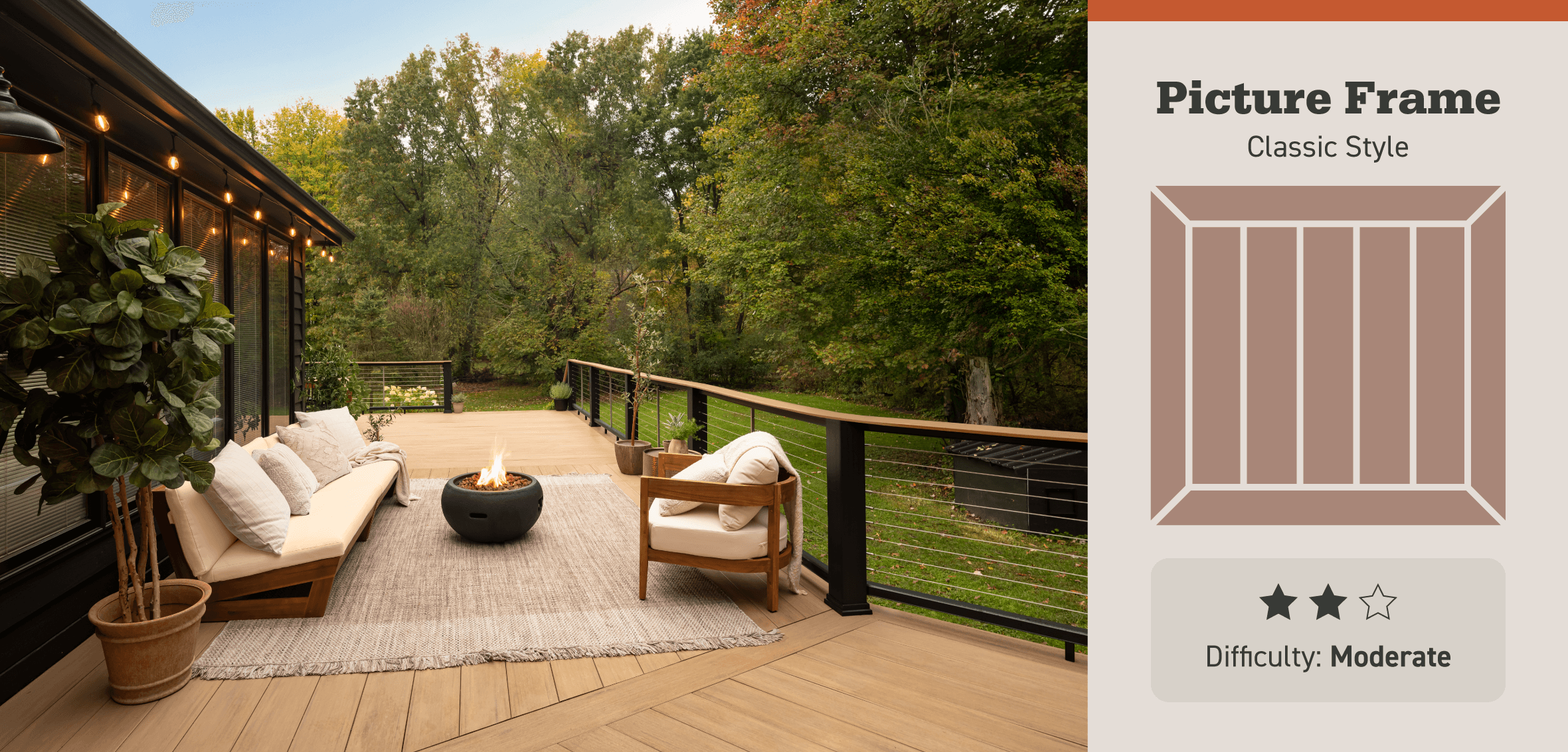
Style: Classic
Difficulty: Moderate
Picture framing a deck involves running at least one layer of deck board around the perimeter of the deck, at the edge of the inlay. Picture frame patterns lend a polished feel to your outdoor living space while staying subtle enough that it doesn’t overwhelm other add-ons like built-in lighting.
Picture frame deck patterns are ideal for those who gravitate toward traditional styles but want a subtle, artistic finish. Highlights of this style include:
- Visually interesting
- Subtle creativity
- Sophisticated finish
3. Playful pinstripe boards
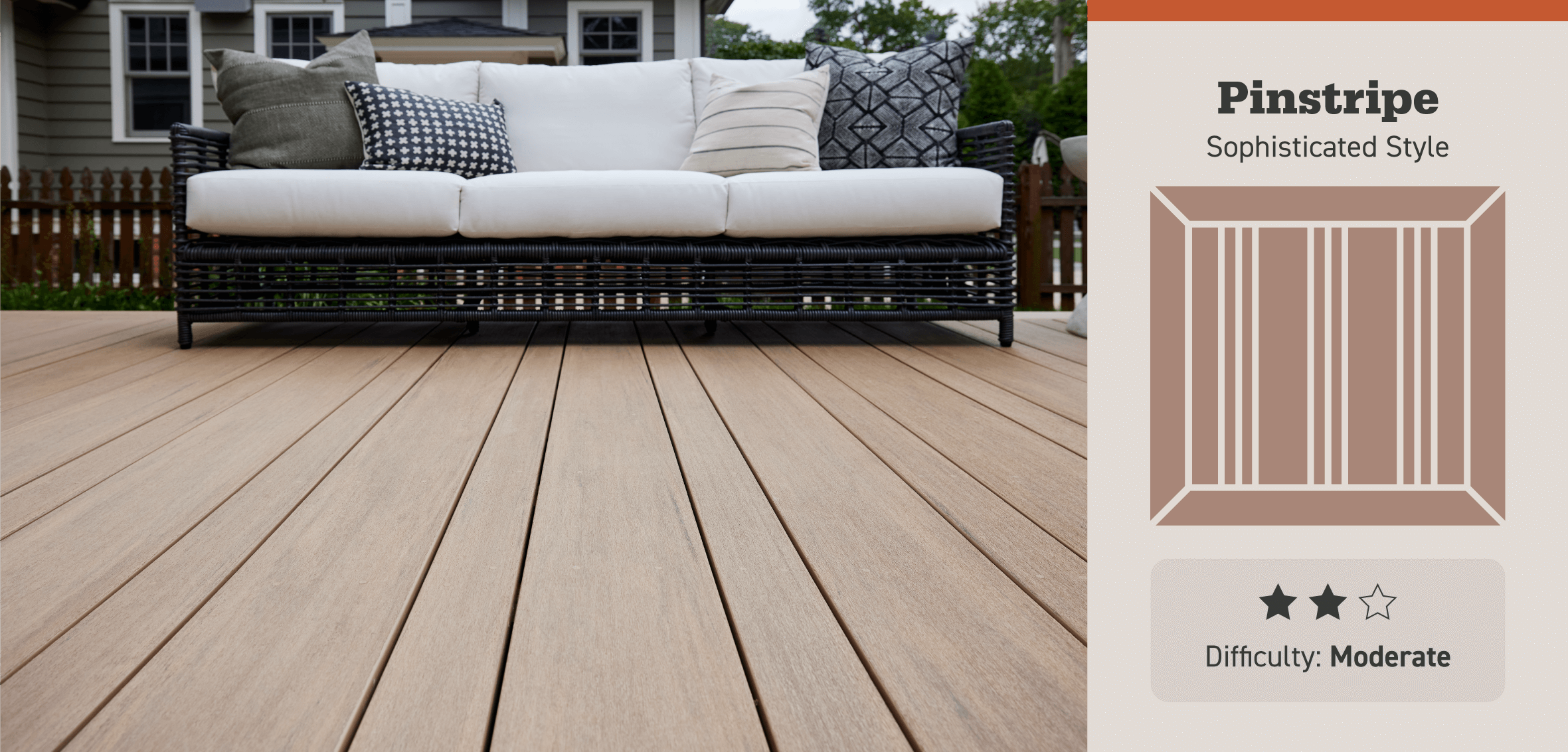
Style: Sophisticated
Difficulty: Moderate
Crisp and coastal-cool, the pinstripe is one of the deck patterns that evokes thoughts of a relaxing and sun-soaked afternoon. Traditionally defined by two narrow boards buffeted by standard or wide-width boards on either side, the pinstripe pattern promises villa vibes even if you don’t live in a tropical climate.
If you enjoy subtle but intentional design and have an eye for detail, this is the deck pattern for you. Pinstripe deck owners will appreciate these highlights:
- Elevated look and feel
- Re-imagined decking
- Faster installation
4. Dynamic diagonal designs
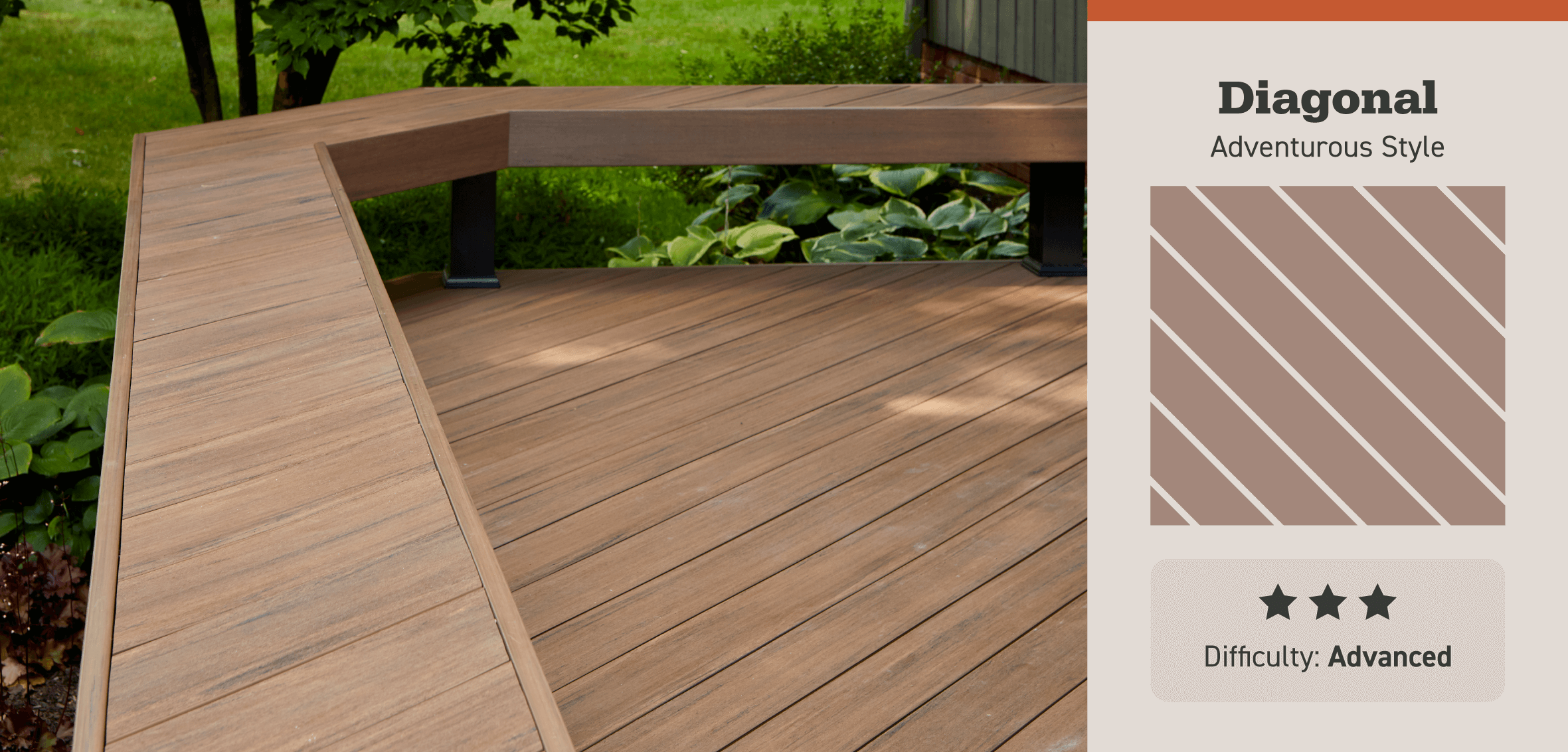
Style: Adventurous
Difficulty: Advanced
Nothing says “dynamic design” like a diagonal inlay. With sleek lines streaming from stage left to right, diagonal deck patterns showcase a high level of stylistic complexity and deliver some serious curb appeal. Diagonal inlay deck patterns are not for the faint of heart — this design is interesting and unique, so expect an outdoor living space that sparks conversation.
This is a more complex pattern that requires a specialized substructure, so we recommend working with a contractor if you want these design benefits:
- Directs flow and dimension
- Contemporary design
- Sophisticated finish
5. Intricate herringbone pattern
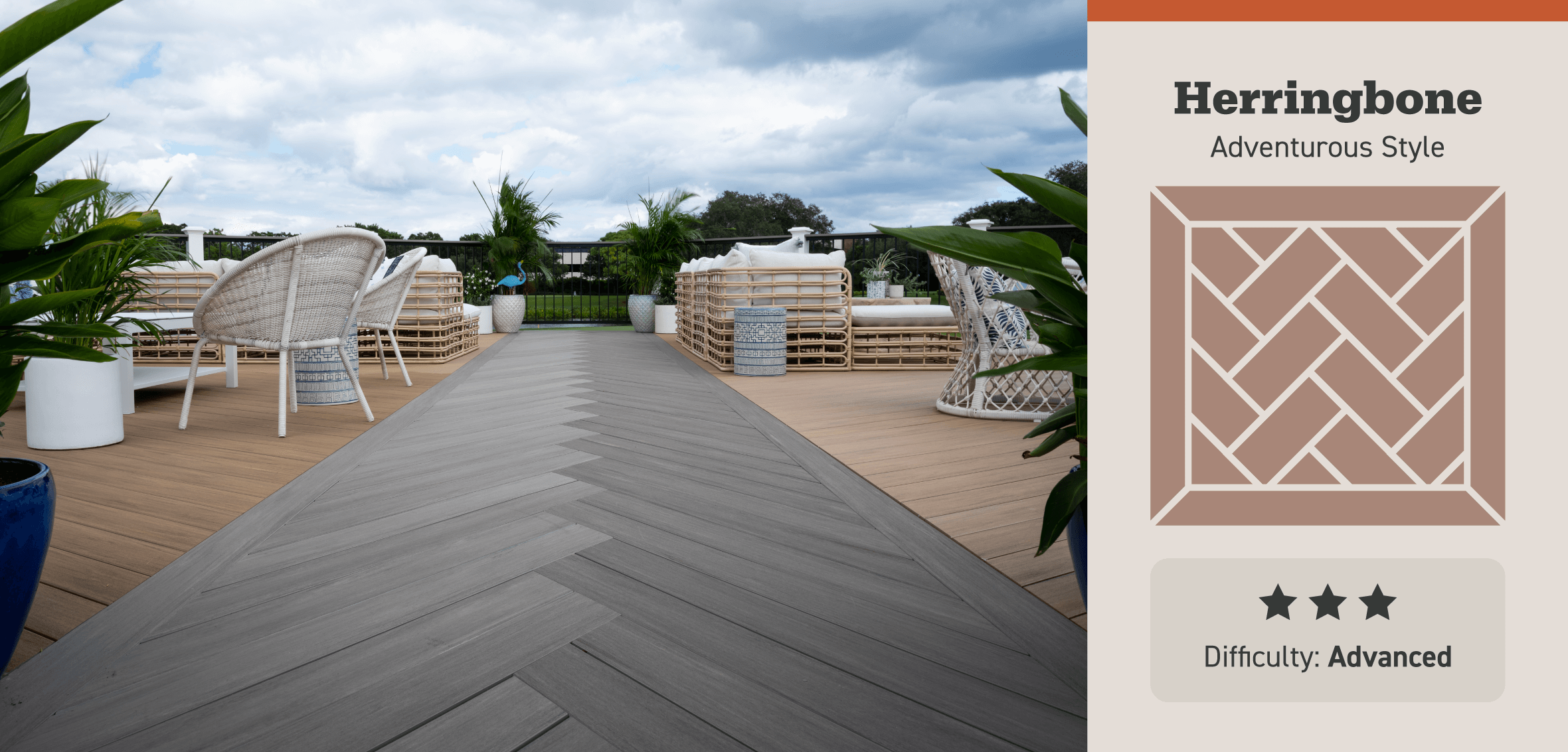
Style: Adventurous
Difficulty: Advanced
Elegant, intricate, and textural, nothing says “luxury decking” quite like a herringbone pattern. Herringbone patterns are formed by repeating instances of two deck boards meeting at 45-degree angles. The crisscrossed, interlocking design evokes the richness of woven textiles and takes a deck from straightforward to statement-making.
Like the diagonal inlays, herringbone patterns are best suited for professionals. Choose a contractor you trust and discuss how you can elevate your design with complementary colors or play with different widths for a custom look.
Herringbone decking patterns have a few perks, including:
- Rich visual interest
- Decor focal point
- Accommodates unique deck designs
6. Geometric tile patchwork

Style: Adventurous
Difficulty: Advanced
Tile deck patterns use adjoining framed portions (“tiles”) with inlays that run perpendicular to one another. The geometric design is pleasing to the eye, and the crisp right angles convey precision and intentionality. They offer the opportunity to get creative with the tile inlays themselves, as well as the potential to add punch with contrasting colors.
Enjoy these advanced style benefits with a tile pattern:
- Elegant look
- Established deck sections
- Enlarged perception of space
7. Timeless transition board ideas
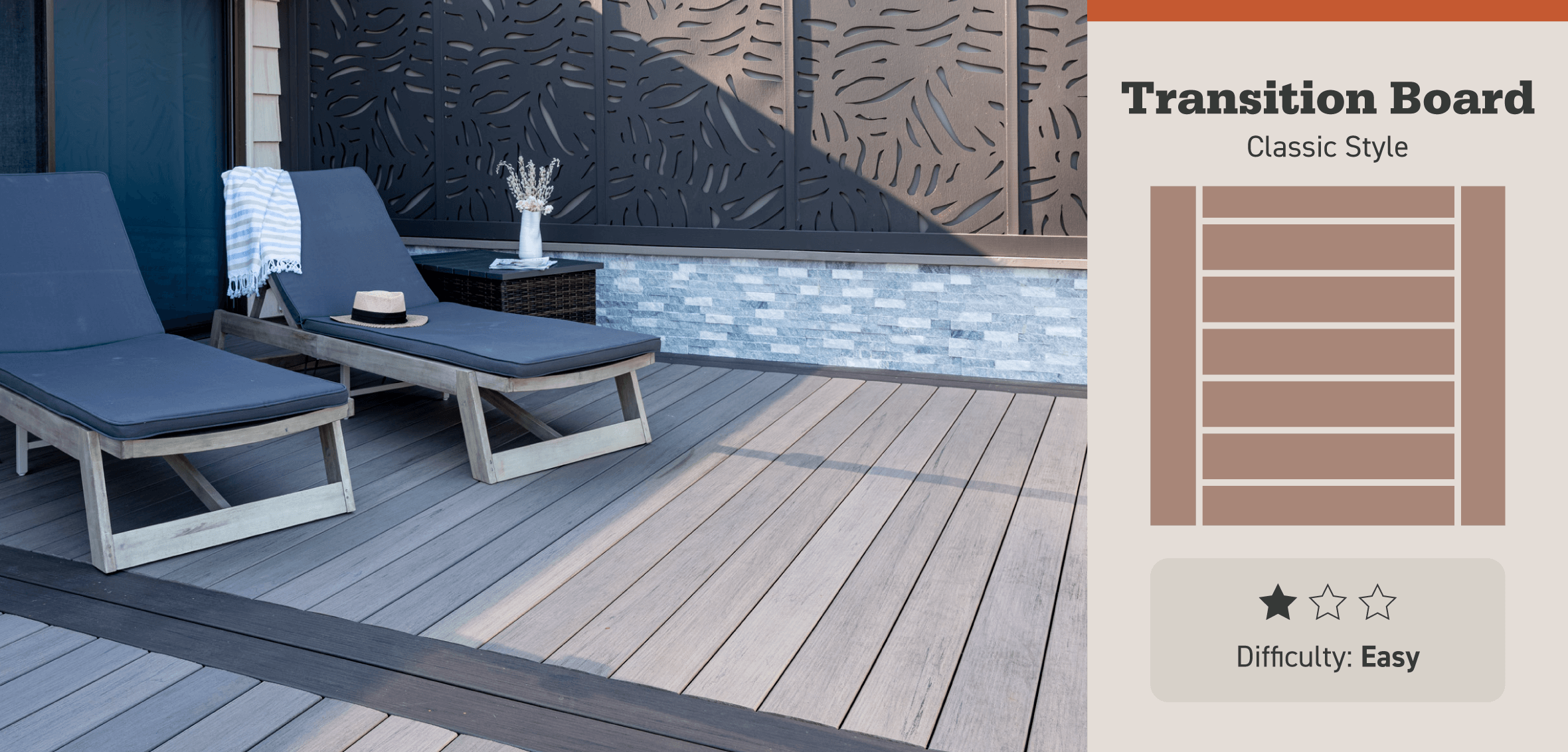
Style: Classic
Difficulty: Easy
Transition boards run between sections of decking and perpendicular to these sections’ boards to add contrast. These can also facilitate a pattern change, similar to the frame around an inlay or tile pattern. They’re a simple addition to your deck design that can be as subtle or bold as you like. Consider playing with different board widths or bold color contrasts for a design that pops, or keep it simple and subtle with complementary colors or matching boards.
Transition boards are great for:
- Visual interest
- Custom look and feel
- Defined deck spaces
8. Classic chevron patterns

Style: Playful
Difficulty: Moderate
A classic and playful chevron pattern combines diagonal decking with transition boards to create a simple angled design. It’s similar to herringbone, but the pattern isn’t quite as complex. Though you will have to cut boards at a consistent angle to pull this look off.
Chevrons level up your deck design and provide a few perks:
- Playful pattern
- Decor focal point
- Defined deck spaces
9. Intricate inlays in any design
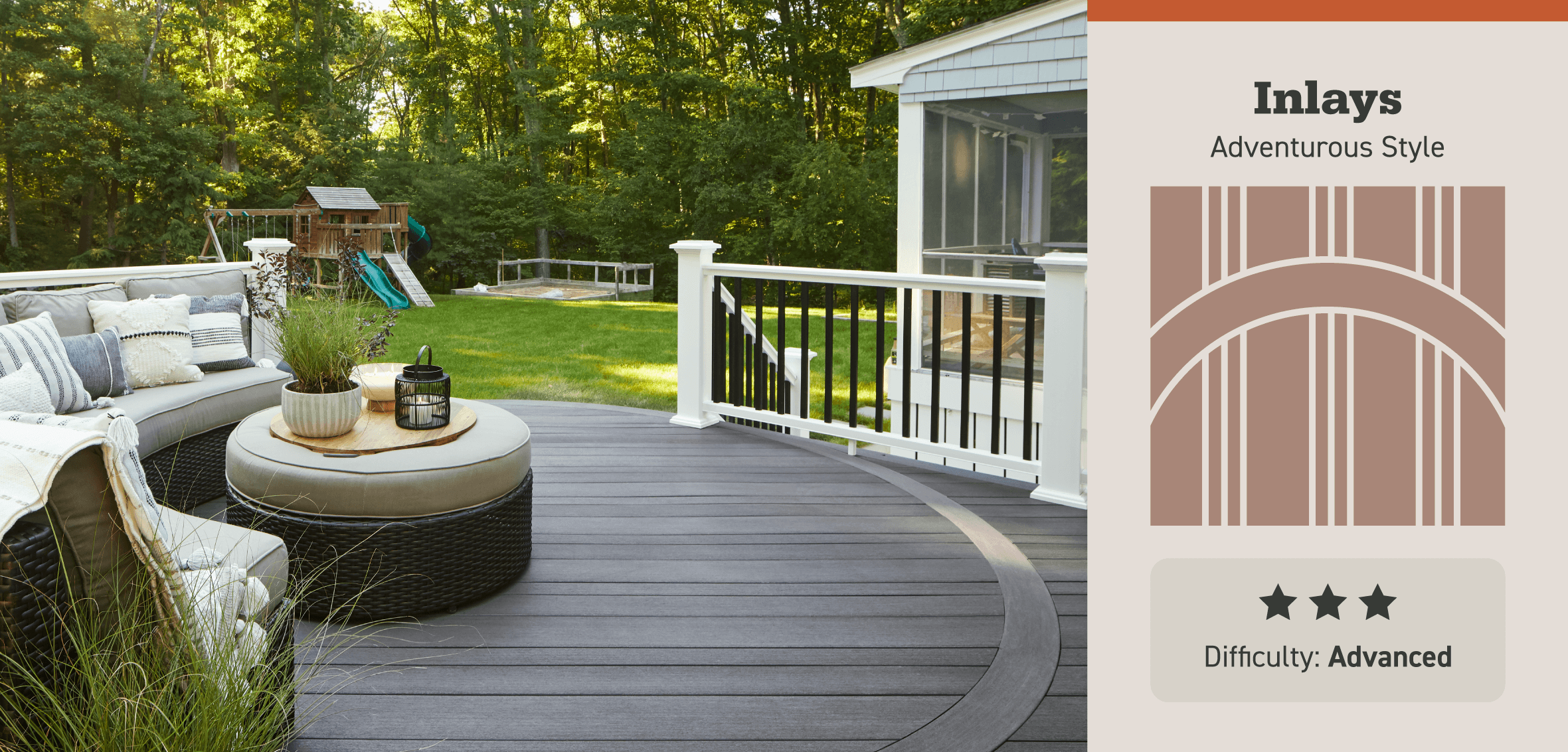
Style: Adventurous
Difficulty: Advanced
Inlays are a great way to transition between designs and introduce creative or complicated patterns without installing it over your whole deck. They can also create a focal point or designated deck space. Even a single-width pattern with a pinstripe inlay adds visual interest and creativity to your deck.
Inlays are the peak of customizable deck designs since you can mix and match patterns. Even simple inlays are more complex than our simplest decking patterns, so it’s best to consult a professional. Creative inlays in your decking provide:
- High-end look and feel
- Customizable style
- Flow and definition
Deck patterns elevate any deck design and allow homeowners to add their personal flair to their outdoor living space. There are several decking patterns available, from simple alternating board widths to complex herringbone patterns.
Some patterns are more advanced than others. It’s always a good idea to find a qualified contractor to discuss your dream deck and collaborate on a plan to bring your vision to life.
